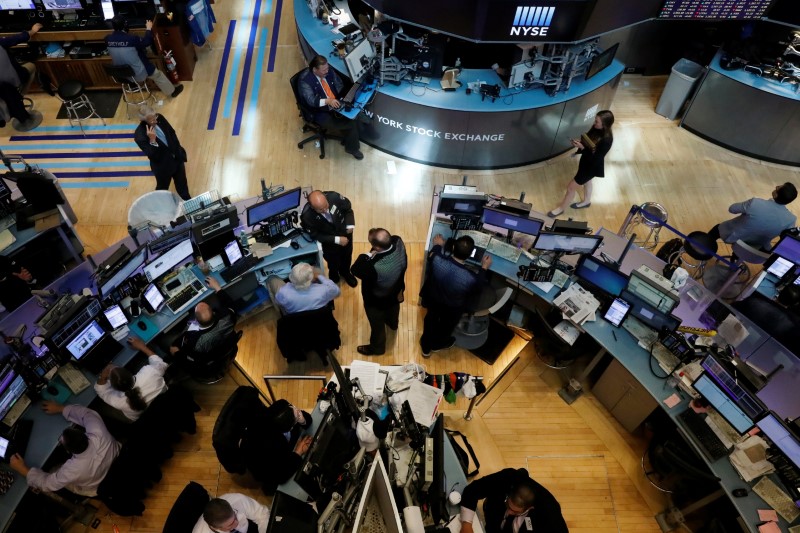Investing.com - U.S. futures pointed to a lower open on Thursday as attention on trade issues switched from the renegotiation of the North American Free Trade Agreement (NAFTA) to the continued impasse between the world’s two largest economies.
The blue-chip Dow futures fell 71 points, or 0.27%, by 6:57 AM ET (10:57 GMT), the S&P 500 futures lost 5 points, or 0.18%, while the tech-heavy Nasdaq 100 futures traded down 16 points, or 0.20%.
Wall Street looked set to take a break on Thursday after the S&P 500 and Nasdaq Composite both closed a day earlier at record highs for a fourth consecutive session.
Stocks have been supported by the fact that U.S. and Canadian leaders have expressed optimism that they could reach new NAFTA deal by a Friday deadline as negotiators prepared to talk through the night, although Canada warned that a number of tricky issues remained.
Under pressure, Canada rejoined the talks to modernize the 24-year-old North American Free Trade Agreement on Wednesday after Mexico and the U.S. announced a bilateral deal on Monday.
U.S. President Donald Trump has set a Friday deadline for the three countries to reach an in-principle agreement.
Assuming renegotiation with Canada and Mexico is successful, the U.S. plans to tackle trade with Europe next and traders received positive news on that front on Thursday as a report from Politico said that the European Union was willing to scrap car tariffs in its U.S. trade deal.
With developments advancing between the NAFTA countries amid hopes for a rapid resolution and trade between Europe and the U.S. expected to follow suit, investors refocused Thursday to see if any more news materializes in what would be the next step on the trade front: the ongoing spat between the U.S. and China.
U.S. tariffs on another $200 billion of Chinese goods are expected to take effect later next month with Beijing warning the Trump administration to back down.
Investors fear an escalating trade war between the world's two biggest economies could hit global growth and damage sentiment.
On the economic agenda, market participants looked ahead to more data on the state of the U.S. consumer with personal income and spending data for July set for release at 8:30AM ET.
Economists expect personal income to rise 0.3% over the prior month, while spending is forecast to gain 0.4%, according to estimates.
The Federal Reserve’s preferred inflation metric, core personal consumption expenditures (PCE), is also set for release in the morning.
The consensus forecast is that the report will show that the core PCE price index inched up 0.2% last month. On an annualized basis, core PCE prices are expected to rise 2%, matching the Fed’s inflation target.
Weekly initial jobless claims numbers come at the same time, with economists predicting a small rise from the previous week.
While waiting for the data, the dollar managed to break four consecutive sessions of losses against rival currencies. At 6:58 AM ET (10:58 GMT), the U.S. dollar index, which measures the greenback’s strength against a basket of six major currencies, was up 0.06% at 94.52.
In company news, Campbell Soup (NYSE:CPB) stock sank more than 4% in pre-market trade on Thursday after the company reported mixed quarterly results and announced it would sell its international businesses and Fresh refrigerated-foods unit, following a months-long strategic review and pressure from hedge fund investors to sell the whole company.
Apart from Campbell, earnings before the opening bell are expected from discount retailers Dollar Tree (NASDAQ:DLTR), and Dollar General (NYSE:DG), as well as Abercrombie & Fitch (NYSE:ANF), Burlington Stores (NYSE:BURL), Kroger (NYSE:KR), Signet Jewelers (NYSE:SIG) and Ciena (NYSE:CIEN).
After the close, Lululemon (NASDAQ:LULU), Ulta Beauty (NASDAQ:ULTA), and American Outdoor Brands (NASDAQ:AOBC) are on deck.
Market participants are also keeping a close eye on Amazon.com (NASDAQ:AMZN) as the company is currently around 3% below reaching a $1 trillion market capitalization, following in the footsteps of Apple (NASDAQ:AAPL) that recently reached the milestone.
Elsewhere, in Europe, nearly all of the region's major bourses were lower, with most sectors in the red.
Earlier, in Asia, markets in the region handed back earlier gains to close broadly lower, with Chinese markets leading losses.
